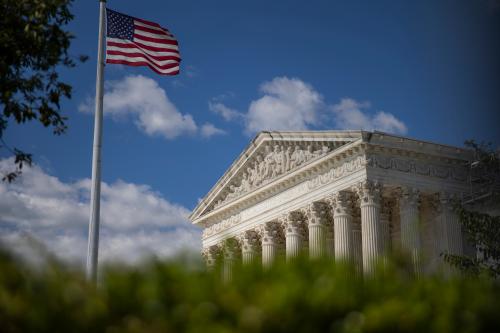A Chinese company’s interest in buying Unocal has raised a big question for the US: how much of our country do we want to sell to a potential adversary? Put more diplomatically, given that the US and China are not allies, and that China is the world’s fastest growing economy: what rules should govern how we invest and trade with it?
Whatever the merits of the Unocal deal, this should be a wake-up call. During the cold war, we developed criteria for determining when to worry if a key global resource or technology was found primarily behind the Iron Curtain. We do not have similar principles to guide relations with China. The proposed Unocal sale to CNOOC should push us to begin this debate.
We propose four benchmarks to assess how much economic dependence on China is too much. The first concerns critical technologies. If China became the world leader in a major strategic technology, we would have to try to limit this trend. Crucial areas include high-energy lasers, advanced optics, submarine quieting equipment, stealth technologies and, perhaps of greatest concern in China’s case, high-performance computers. While not trying to disrupt China’s own legitimate advances, we should oppose transfers of advanced strategic western technologies to its ownership.
The second benchmark relates specifically to computer technology. Even if China does not become a leader in supercomputer development soon, it could easily become the dominant world producer of chips, computers or software. It is already the leading exporter of computers, with nearly 20 per cent of the global market last year, although China’s expertise is primarily in inexpensive production of lower-end machines. The world needs several suppliers of computer capabilities so that others can increase production if China cuts the US off in a future crisis; thankfully, we still have them. However, should the Chinese share of global computer trade increase by 50 to 100 per cent, more assertive policy measures could be required.
Meanwhile, preserving US leadership in the critical technology field demands more proactive domestic policies encouraging research and development, science and engineering education, and workforce training.
The third point relates to important natural resources. This is where oil and Unocal come in. The situation with essential energy sources can be more nettlesome than for a product such as computers, where others could increase production quickly if China ever threatened to cut its own off during a security crisis. China’s share of global oil production is modest and well below what it needs for its own consumption—a useful benchmark for assessing potentially troublesome dominance. Unocal accounts for much less than 1 per cent of global oil production (China’s total assets account for well under 10 per cent). Rather than seeking domination of world oil markets, Chinese leaders probably want assurances over their energy supplies given their economy’s extreme dependence on the resource. Moreover, given the amount of dollars we are putting in China’s pockets through our enormous appetite for imports, we should not be surprised that Beijing would seek higher yielding investments than Treasury bonds.
The final benchmark is the question of overall economic dependence. Leaving aside the specifics about what trade the US carries out with China, it is not prudent to allow a huge share of the US economy to depend on favourable future political relations with one of the world’s last great autocratic states. Although overall imports from China account for just 2 per cent of US gross domestic product, the nation depends heavily on China to finance its deficit. China’s recent loosening of the renminbi is not likely to change the situation dramatically. An old-fashioned mercantilist perspective would decry American dependence on a rival state to finance its fiscal profligacy and shore up the dollar. More sanguine observers find reassurance in double jeopardy: China would be exposed to hefty capital losses if it offloaded its dollar assets impetuously.
The best way to address this problem is through fiscal policy and further exchange rate realignment, not trade or investment policy. As for owning US companies, China is a long way from buying up America. Its direct investment in the US is less than $1bn (about $2bn counting investments from Hong Kong), compared with US investment in China of over $15bn ($60bn including Hong Kong)—and a fraction of the $1,500bn of total foreign investment in the US. One should remember that when Japan went on a US buying spree two decades ago, a sharp fall in the dollar and real estate valuations turned it into a bonanza for American sellers.
The Unocal bid has sparked a sobering debate on how much of the US—and the world—we can safely see controlled by a communist regime with a claim on Taiwan that the US is not prepared to concede and could well fight to oppose. Few issues will be as important or intellectually challenging for American policymakers in the decades ahead.


Commentary
Op-edA Test of American Independence
July 26, 2005